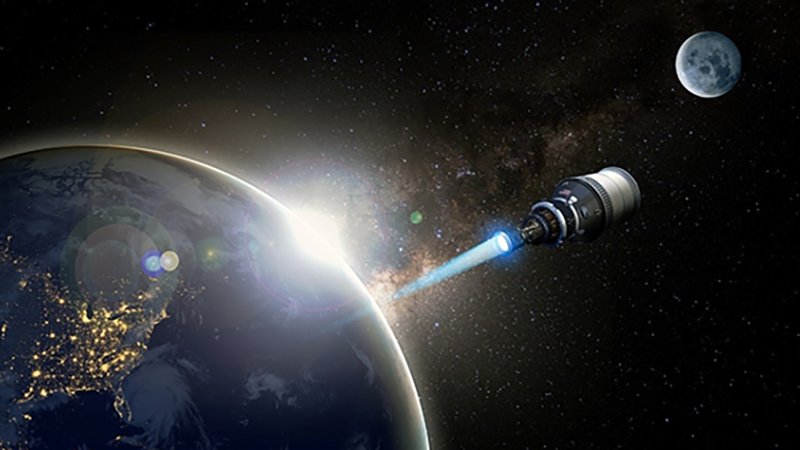
An artist’s illustration of a nuclear-powered rocket. (DARPA)
As humanity gets closer and closer to leaving footprints on Mars, questions remain about the best way to get there — and how to travel much farther into the unknown. In this op-ed, Dr. Mark Lewis argues that an idea from early in the Cold War is having something of a much-deserved renaissance: nuclear-powered rockets.
The 1965 edition of the World Book Encyclopedia that I grew up with promised that the United States would land astronauts on Mars by 1986 using nuclear thermal rockets. As is apparent, we’re not quite there yet.
But nuclear power for space-bound rockets wasn’t science fiction even in the 1960s, and 60 years later multiple programs are rediscovering this promising technology. In fact, one of the most exciting recent developments in space technology is a return to that vision, as nuclear power systems and nuclear rockets are once again a focus at both NASA and the Department of Defense.
In December of last year, the White House released Space Policy Directive 6, which established a national strategy to develop both space nuclear power and nuclear propulsion. Despite the change in administration, enthusiasm for nuclear power and propulsion seems to be holding. The Defense Innovation Unit released a solicitation on September 9 that invited industry to provide information on a compact nuclear power plant that would be appropriate for powering small and medium sized spacecraft.
Another program already in the works at the DOD Strategic Capabilities Office is Project Pele, with the goal of developing a transportable nuclear reactor. Though not specifically for space applications, lessons learned as part of Pele will help inform space reactor development.
Work is also spinning up on the development of safe, reliable nuclear thermal rockets. To that end, DARPA’s Demonstration Rocket for Agile Cislunar Operations (DRACO), with its goal of demonstrating a nuclear thermal rocket in orbit, is going strong.
It’s all very exciting, though considerably delayed, from the naively optimistic predictions of my 1965 encyclopedia, which also declared that nuclear thermal engines would power Saturn V rockets in some of the later Apollo missions. Those assertions did have a basis in fact; at the time that edition of the World Book was published, the US government had already been working on nuclear rockets for about a decade.
As part of the Kiwi and subsequent Nuclear Engine for Rocket Vehicle Application (NERVA) programs, prototype engines were built and tested that delivered significantly higher thrust per rate of fuel consumption than any chemical engine built before or since. In a series of ground tests, nuclear engines were shown to be reliable and restartable, and could operate for extended periods, including nearly a half hour of continuous thrust.
By the late 1960’s, as NASA’s plans for lunar exploration were being scaled back, the NERVA program lost support in the White House, and was ultimately cancelled outright in 1973 before a nuclear thermal engine was ever flown in space.
Nuclear reactors for generating power were also a topic of great interest starting in the early days of the space flight. Nuclear power systems can provide electric power for spacecraft without tying them to solar panels, for which there are a number of intriguing applications for both civil and military space. One of those applications is the use of nuclear power to generate electricity to power electric propulsion systems.
The US flew the SNAP nuclear reactor in 1965, then all but abandoned the technology.
The Soviet Union had a far more extensive program, with an entire series of satellites powered by reactors. There were even plans to purchase Russian-built TOPAZ-II space nuclear reactors for various American spacecraft in the 1990’s, and though several such reactors were brought to the US, flight plans never came to fruition.
Nuclear Vs. Chemical: A Lesson In Physics
The development of nuclear thermal rockets will enable a range of space missions that are challenging to even the best chemical rockets. To understand the value of nuclear thermal propulsion, it’s instructive to compare the potential performance of nuclear thermal rockets to more traditional chemical systems.
In a chemical rocket, a chemical reaction between fuel and oxidizer produces products that are also heated by the release of chemical bond energy; both the amount of heat available and the properties of the exhaust mass are thus determined by the chosen reactants. In contrast, in a nuclear thermal rocket, a fission reactor is used to heat some working fluid, such that the source of the heat and the properties of the exhaust mass are essentially uncoupled.
A rocket’s thrust per rate of fuel weight consumption is known as its specific impulse, or Isp. All else being equal, the velocity increase imparted to a spacecraft is directly proportional to Isp. As a general rule, for high-thrust systems, the lower the molecular weight of the exhaust mass, the higher the Isp for a given amount of energy.
Because low molecular weight fuels such as hydrogen can be used in a nuclear thermal rocket, unconstrained by chemistry, nuclear systems can deliver values of Isp that are about twice those of the best chemical systems.
A nuclear rocket could also offer the flexibility of using fuel that is derived locally in other parts of the solar system, including the atmosphere of Mars.
Note that nuclear thermal rockets are different than nuclear electric engines that would use a reactor as an electric power source. Such electric engines have significantly higher specific impulse than even nuclear thermal systems and could operate for very long periods of time but produce extremely low thrust levels.
A Better Way to Mars
Nuclear rockets are thus a demonstrated technology that could enable an exciting range of possible future civil and military space missions. For example, they could decrease flight time to Mars compared to other proven propulsion concepts. This in turn would reduce life support requirements.
Nuclear thermal rockets could also allow for broader launch windows to Mars and greater opportunities for aborts back to earth. This means that nuclear propulsion could actually reduce the overall radiation hazard to a human crew and ultimately make for safer missions compared to chemical or electric engines.
Fission reactors can be designed to survive a launch failure without threat of accidental radiation leaks. Indeed, there are arguably fewer risks in launching a nuclear reactor than the radioisotope thermoelectric generators we launch today.
For the Department of Defense, nuclear thermal rockets hold the potential for more maneuverable spacecraft, capable of avoiding threats or changing orbits for more flexible mission operations in the increasingly contested space environment.
Like their terrestrial counterparts, the use of space nuclear systems has been limited more by policy and perception than by technological readiness. If the US is truly serious about a future that includes humans on Mars and regular operations in cislunar space, nuclear power, and especially its application to nuclear rocket propulsion, must be an option.
To that end, current efforts in the development of nuclear thermal systems are indeed a wise and timely investment.
Dr. Mark J. Lewis is the Executive Director of National Defense Industrial Association’s Emerging Technologies Institute (NDIA ETI). Prior to this position, Dr. Lewis was the Director of Defense Research & Engineering in the Department of Defense (DoD), overseeing technology modernization for all Services and DoD Agencies, as well as the acting Deputy Under Secretary of Defense for Research & Engineering.






















